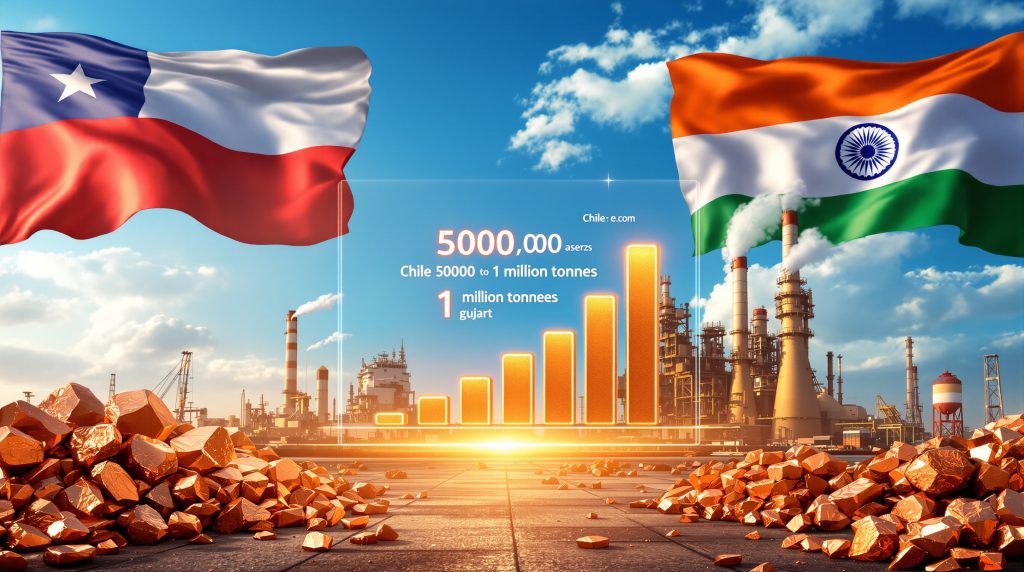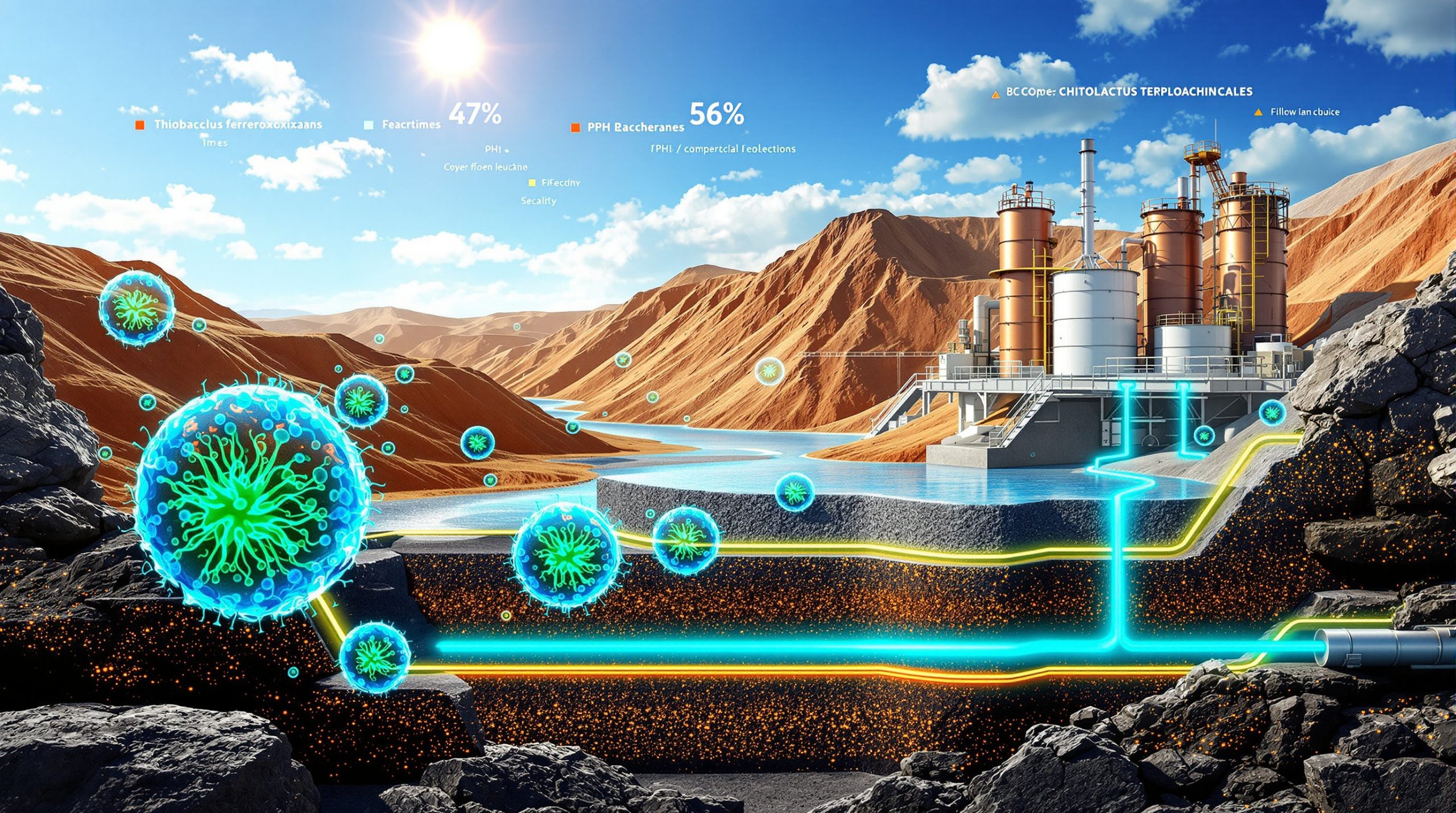The transformation of international mining alliances reflects a fundamental shift in how resource-dependent nations approach commodity security. Traditional spot market purchasing has given way to integrated development partnerships, particularly in sectors where supply disruptions carry cascading economic consequences. This evolution becomes especially pronounced in copper markets, where technological advancement and energy transition demands intersect with geopolitical supply chain vulnerabilities. Furthermore, recent Codelco copper strategy developments highlight this strategic realignment.
India's copper supply landscape exemplifies this strategic realignment. Following the 2018 closure of Vedanta's Sterlite facility, which eliminated approximately 95% of domestic refined copper production capacity, the nation transitioned from near self-sufficiency to importing over 650,000 tonnes annually. This dependency coincides with accelerating demand from renewable energy infrastructure, electric vehicle manufacturing, and grid modernization projects requiring copper-intensive technologies.
Chile's position as the world's largest copper producer, accounting for 28% of global output through companies like Codelco, creates opportunities for bilateral resource partnerships that extend beyond traditional buyer-seller relationships. The recent Codelco and Adani exploration deal in Chile represents this emerging framework, combining supply security with joint development potential across multiple Chilean copper projects.
Strategic Supply Chain Diversification Through International Mining Partnerships
Contemporary mining alliances demonstrate sophisticated risk management strategies that transcend conventional commodity trading relationships. The November 2025 non-binding agreement between Codelco and Adani's Kutch Copper subsidiary establishes a framework for technical collaboration across three Chilean copper projects while addressing India's long-term supply security requirements. This development aligns with broader copper investment strategies emerging in global markets.
This partnership model reflects broader industry trends where state-owned enterprises leverage international relationships to achieve multiple strategic objectives simultaneously. Codelco's approach includes:
- Technology integration partnerships: Collaboration with Japan's NTT DATA for artificial intelligence and robotics applications in mining operations
- Market diversification initiatives: Reducing dependence on Chinese markets, which historically absorbed 40-45% of Chilean copper exports
- Downstream value creation: Exploring processing and refining partnerships in key consuming markets
The economic rationale centers on supply chain resilience rather than pure cost optimization. India's copper import dependency creates vulnerability to price volatility and supply disruptions, while Chile benefits from diversified customer relationships that reduce concentration risk in Asian markets dominated by Chinese consumption patterns.
Regional Processing Hub Development Strategy
Adani's Kutch copper processing facility represents a critical component in India's copper supply security architecture. Currently operating at 500,000 tonnes annual capacity with planned expansion to 1 million tonnes, the Gujarat-based facility provides integrated smelting capabilities that complement direct partnership arrangements with overseas producers.
The strategic location within Gujarat's industrial corridor offers logistical advantages for copper concentrate imports from Chile via established shipping routes through the Suez Canal. According to Bloomberg's coverage of the partnership announcement, freight costs averaging $150-250 per tonne for Chile-to-India transport create economic viability for long-term supply agreements, particularly when combined with premium pricing arrangements that provide stability over spot market exposure.
India's copper processing expansion aligns with broader industrial policy objectives targeting increased domestic value addition in critical materials. The planned capacity doubling at Kutch supports:
- Manufacturing sector growth requiring 8-10% annual copper demand increases
- Renewable energy capacity expansion targeting 500 GW by 2030
- Electric vehicle production scaling with 30% penetration targets for passenger vehicles
- Smart grid infrastructure development requiring copper-intensive distribution upgrades
Bilateral Resource Partnership Models in Critical Materials
The structure of modern mining partnerships reveals sophisticated risk sharing mechanisms that address both geological and market uncertainties. The Codelco and Adani exploration deal in Chile includes technical due diligence processes for three undisclosed Chilean copper projects, establishing information exchange protocols that precede binding development commitments.
This approach differs fundamentally from traditional mining investment models where foreign partners provide capital for established projects. Instead, joint evaluation processes allow both parties to assess:
- Geological resource potential: Copper grade characteristics and reserve estimates through shared technical analysis
- Development feasibility: Engineering requirements and capital intensity assessments
- Environmental compliance: Regulatory frameworks across Chilean jurisdictions and international standards
- Market positioning: Long-term demand projections and pricing mechanism structures
The non-binding nature of initial agreements reflects industry recognition that mining project development carries extended timelines typically requiring 2-3 years for exploration and feasibility studies, followed by 3-5 years for engineering and permitting processes, and 4-6 years for construction phases.
International Mining Investment Framework Analysis
Comparative analysis of recent mining partnerships reveals distinct strategic approaches among major producers. In addition, current copper price predictions influence partnership negotiations and long-term planning decisions. The following framework illustrates positioning across different alliance models:
| Partnership Structure | Geographic Focus | Timeline | Strategic Objective |
|---|---|---|---|
| Supply Security Agreements | Bilateral (Producer-Consumer) | 5-15 years | Market access and price stability |
| Technology Collaborations | Multi-regional | 3-7 years | Operational efficiency and innovation |
| Joint Development Ventures | Project-specific | 10-20 years | Resource development and revenue sharing |
| Processing Partnerships | Regional hubs | 15-25 years | Value chain integration and capacity expansion |
Chile's strategic positioning leverages its dominant copper reserves, estimated at approximately 200 million tonnes or 23% of global identified resources, to support multiple partnership configurations simultaneously. This approach enables risk diversification across geographic markets while maintaining flexibility in responding to changing demand patterns.
India's Critical Materials Acquisition Strategy Post-Sterlite
The 2018 closure of Vedanta's Sterlite copper smelter in Tamil Nadu represents a watershed moment in India's industrial resource strategy. The facility's 400,000 tonnes annual capacity constituted virtually all domestic refined copper production, creating immediate supply gap pressures that required rapid import scaling and alternative sourcing arrangements.
Environmental concerns and local opposition that led to the permanent shutdown highlighted vulnerabilities in concentrated domestic production models. The facility closure displaced over 3,200 direct employees and eliminated approximately 8,000 indirect jobs, while forcing Indian manufacturers to transition entirely to imported copper supplies within months.
Subsequent import dependency reached 95-98% of total consumption, with refined copper imports increasing from approximately 200,000 tonnes in 2017 to over 650,000 tonnes by 2024. This transformation occurred during a period of accelerating demand driven by:
- Infrastructure modernization: Railway electrification programs requiring ~500,000 tonnes of copper for 5,000+ km of track conversion
- Smart meter deployment: 250 million unit installation targets requiring ~150,000 tonnes of copper
- Renewable energy scaling: Solar and wind projects requiring 4-5 tonnes of copper per megawatt of installed capacity
- Electric vehicle transition: EV copper content averaging 25-50 kg per vehicle compared to 8-10 kg in conventional vehicles
Supply Security Economics and Market Dynamics
India's copper supply challenge extends beyond simple import substitution to encompass strategic materials security in economic development planning. Unlike countries with established mining sectors or diversified supplier relationships, India's sudden transition to complete import dependency created vulnerability to price manipulation and supply disruption scenarios.
The economic impact manifests across multiple dimensions:
Trade Balance Effects:
- Copper imports contribute $4-6 billion annually to India's trade deficit
- Price volatility creates unpredictable foreign exchange requirements
- Long-term contracts provide budget certainty for industrial planning
Industrial Competitiveness:
- Copper price fluctuations directly impact manufacturing costs across electronics, automotive, and construction sectors
- Supply disruption risks threaten production scheduling and delivery commitments
- Quality consistency requirements favor established supplier relationships
Strategic Autonomy Considerations:
- Critical materials dependency limits policy flexibility in international relations
- Domestic processing capacity provides employment and technical capability development
- Regional supply partnerships reduce dependence on single-country sources
The Adani partnership framework addresses these concerns through integrated supply and processing arrangements that combine long-term price stability with capacity expansion supporting India's industrial growth trajectories.
Technology Integration and Operational Excellence
Modern mining partnerships increasingly incorporate technological collaboration components that extend beyond traditional supply relationships. Codelco's simultaneous partnerships with Japan's NTT DATA for artificial intelligence applications and India's Adani for supply security demonstrate multi-dimensional alliance strategies. However, broader AI transforming mining developments are reshaping operational capabilities across the industry.
Key technology focus areas include:
- Artificial Intelligence: Predictive maintenance, ore grade optimization, and equipment performance monitoring
- Robotics Integration: Autonomous mining equipment, remote operation capabilities, and safety enhancement systems
- Environmental Technology: Emission reduction systems, water management innovations, and waste processing improvements
- Digital Infrastructure: Real-time monitoring systems, supply chain transparency, and quality assurance protocols
These technological partnerships create competitive advantages that complement supply security arrangements, enabling operational efficiency improvements that benefit all parties while strengthening long-term collaborative relationships. Consequently, the mining industry evolution reflects these technological advances across global operations.
What Are the Benefits of AI Integration in Mining Operations?
Artificial intelligence integration in mining operations provides substantial benefits across operational efficiency, safety, and cost reduction dimensions. Predictive maintenance systems reduce equipment downtime by 15-25% through real-time monitoring and failure prediction algorithms.
Ore grade optimization enables processing efficiency improvements of 8-12% by analyzing geological data and adjusting extraction parameters in real-time. Safety enhancement systems reduce incident rates through automated hazard detection and remote operation capabilities that minimise human exposure to dangerous conditions.
Economic Impact Assessment and Revenue Projections
The economic implications of major mining partnerships extend beyond direct commodity transactions to encompass broader trade relationships, employment creation, and industrial development outcomes. Analysis of the Chile-India copper partnership reveals multi-layered economic benefits distributed across both participating nations.
Revenue and Employment Generation Analysis
Chile Economic Benefits:
- Export revenue diversification reduces dependence on Chinese market concentration
- Premium pricing potential through long-term contracts versus spot market exposure
- Technology transfer and operational efficiency improvements through collaborative development
- Employment expansion in mining operations and associated technical services
India Economic Benefits:
- Supply price stability reduces import cost volatility and supports industrial planning
- Domestic processing capacity expansion creates approximately 2,000-3,000 direct jobs and 5,000+ indirect positions
- Manufacturing sector competitiveness improvement through reliable copper supply arrangements
- Technical capability development in copper processing and quality control systems
Trade Balance and Currency Considerations
Long-term copper supply agreements provide currency hedging benefits that extend beyond simple commodity price protection. Structured pricing mechanisms typically include:
- Base price determination: Quarterly or annual price setting based on market fundamentals
- Premium adjustments: Regional premiums reflecting transportation costs and market conditions
- Quality specifications: Grade-based pricing differentials ensuring consistent material standards
- Force majeure provisions: Supply disruption protection and alternative sourcing arrangements
These contract structures reduce foreign exchange risk for Indian importers while providing Chilean exporters with predictable revenue streams that support long-term capital investment planning in mining capacity expansion.
| Economic Metric | Chile Impact | India Impact |
|---|---|---|
| Annual Trade Value | $2-3 billion export revenue | $2-3 billion import stability |
| Employment Creation | 5,000+ mining sector jobs | 7,000+ processing sector jobs |
| Technology Development | AI/robotics adoption | Processing capability advancement |
| Regional Development | Northern Chile mining districts | Gujarat industrial corridor |
Risk Assessment and Operational Challenges
International mining partnerships face complex risk profiles encompassing geological uncertainties, regulatory changes, market volatility, and operational disruptions. Comprehensive risk assessment frameworks enable partners to develop mitigation strategies that protect long-term collaborative objectives while maintaining operational flexibility.
Geological and Technical Risk Factors
The three Chilean copper projects under review in the Codelco and Adani exploration deal in Chile represent different categories of geological risk based on development stage and resource characterization. Typical risk assessment criteria include:
Resource Certainty Levels:
- Measured resources with detailed geological modeling and extensive drilling data
- Indicated resources with sufficient sampling for preliminary economic assessment
- Inferred resources requiring additional exploration for development planning
Grade and Recovery Considerations:
- Ore grade consistency affecting processing costs and revenue projections
- Metallurgical recovery rates determining actual copper content extraction
- Environmental compliance requirements influencing processing methodology selection
Infrastructure Development Requirements:
- Transportation access to existing port and processing facilities
- Power supply availability and costs for energy-intensive mining operations
- Water resources for processing and environmental management systems
Technical due diligence processes typically require 18-24 months for comprehensive evaluation, including independent geological assessment, engineering feasibility studies, and environmental impact analysis.
What Regulatory Challenges Do Cross-Border Mining Partnerships Face?
Cross-border mining partnerships operate within complex regulatory environments that require ongoing compliance monitoring and stakeholder engagement. Key regulatory considerations include:
Chilean Mining Regulatory Framework:
- Environmental Impact Assessment requirements under Law 19,300
- Foreign investment protections through Chilean Investment Promotion Agency oversight
- Progressive copper royalty regime ranging from 5-14% based on price and profitability levels
- Community engagement and indigenous rights consultation requirements
Indian Import and Processing Regulations:
- Copper import duty structures affecting landed costs (currently 2.5% on refined copper)
- Environmental compliance for processing facility operations
- Foreign investment approval processes through relevant ministries
- Quality standards and certification requirements for industrial applications
Effective risk management requires legal frameworks that address dispute resolution mechanisms, force majeure provisions, and regulatory change accommodation procedures.
Global Copper Market Positioning and Pricing Dynamics
The expansion of bilateral mining partnerships influences global copper market structure by reducing reliance on spot market transactions and creating alternative pricing mechanisms that reflect long-term supply-demand relationships. These developments affect market liquidity patterns and regional premium adjustments across major consuming markets. Additionally, Mining Technology reports indicate growing interest in such strategic partnerships.
Supply Chain Diversification Impact on Market Structure
Traditional copper market concentration, particularly Chinese dominance representing over 50% of global consumption, creates systemic pricing risks that bilateral partnerships help mitigate. Diversification effects include:
Market Share Redistribution:
- India's growing consumption (currently ~4% of global total) provides alternative demand outlet
- Reduced Chinese pricing influence through expanded customer base diversity
- Regional premium adjustments reflecting transportation costs and local market conditions
Contract Structure Evolution:
- Long-term agreements (5-15 years) versus spot market transactions
- Pricing mechanisms incorporating quality premiums and delivery reliability factors
- Risk sharing arrangements for price volatility and supply disruption scenarios
Global Supply Response:
- Increased investment in copper production capacity to serve growing partnership demand
- Technology adoption acceleration to improve operational efficiency and cost competitiveness
- Environmental performance improvements to meet international partnership standards
Current copper pricing at $4.98 per pound reflects market recognition of supply constraint concerns amid accelerating demand from energy transition applications and infrastructure development programs globally.
Investment Opportunities in Copper Value Chain Development
The evolution toward integrated mining partnerships creates investment opportunities across the entire copper value chain, from upstream exploration and development through downstream processing and manufacturing applications.
Upstream Investment Potential:
- Chilean copper project development requiring $3-8 billion for major greenfield operations
- Exploration and resource expansion in established mining districts
- Technology integration for operational efficiency and environmental performance improvements
Midstream Processing Expansion:
- Indian smelting and refining capacity growth to support 1 million tonne annual processing targets
- Regional processing hub development serving broader Asian markets
- Quality control and certification systems meeting international standards
Downstream Manufacturing Integration:
- Copper-intensive manufacturing in renewable energy equipment production
- Electric vehicle component manufacturing requiring specialized copper alloys
- Construction and infrastructure applications supporting urbanization programs
These investment opportunities align with broader energy transition trends while supporting supply security objectives for participating nations in strategic mining partnerships. Furthermore, the Codelco and Adani exploration deal in Chile demonstrates how bilateral partnerships create pathways for integrated value chain development.
Disclaimer: This analysis contains forward-looking assessments based on current market conditions, regulatory frameworks, and announced partnership intentions. Actual outcomes may vary significantly due to changes in commodity prices, regulatory policies, technological developments, or economic conditions. Readers should conduct independent research and consult qualified professionals before making investment decisions related to mining partnerships or copper market investments.
Are You Positioning for the Next Breakthrough in Copper Exploration?
Discovery Alert's proprietary Discovery IQ model delivers instant notifications on significant copper discoveries across the ASX, enabling investors to capitalise on actionable opportunities like the Chile-India partnership developments before broader market recognition occurs. Access historic discovery returns and begin your 30-day free trial today to secure your competitive advantage in identifying tomorrow's major mineral breakthroughs.




